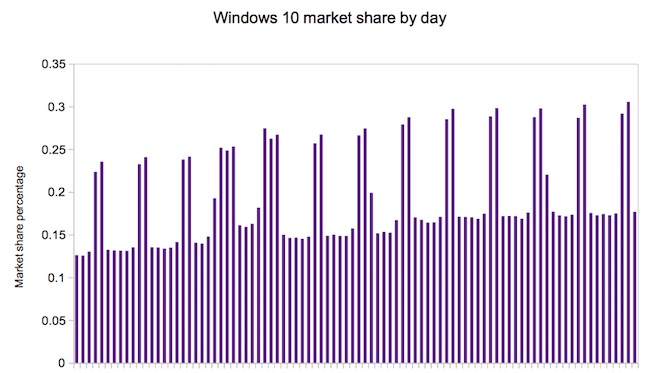This article is more than 1 year old
Windows 10 claimed another point of desktop share in February
Windows 8.x is fading fast, but XP hangs on, and on, and on ...
Windows 10 is still growing, but its rate of growth has flattened to about one per cent of market share per month.
El Reg makes that assertion on the basis of our monthly look at three sources of data: the ratings firms Netmarketshare and StatCounter, plus the US government's analytics dump of 90 days of windows-sourced traffic to public sector web sites.
Netmarketshare's data has Windows 10's market share up from 11.85 per cent in January to 12.82 per cent in February. Windows 7 dipped just 0.13 per cent to 52.34 per cent and Windows XP shed just 0.18 per cent. The biggest loser was therefore Windows 8.1, down 0.57 per cent to 9.83 per cent market share in February.
StatCounter has Windows 10 jumping from 13.65 per cent market share in January to 14.86 per cent in February. Windows 7 leads its market share ratings for February at 46.08 per cent, down 0.48 per cent for the month. Windows 8.1 dipped just 0.24 per cent to 11.43 per cent in the firm's ratings.
Uncle Sam reports similar trends. Here's our table of its last 90 days of Windows share data:
| Windows 7 | Windows 8 | Windows 8.1 | Windows 10 | Server 2003 | Vista | XP | |
|---|---|---|---|---|---|---|---|
| Dec | 64.11% | 1.44% | 12.88% | 15.61% | 0.07% | 2.41% | 3.47% |
| Jan | 63.01% | 1.42% | 11.95% | 17.98% | 0.06% | 2.38% | 3.20% |
| Feb | 62.53% | 1.40% | 11.69% | 19.18% | 0.06% | 2.22% | 2.93% |
Again, we see about ~1 per cent jump for Windows 10 and smaller dips for older Windows versions.
W've also crunched the numbers again to calculate the percentage of traffic Windows 10 represents to US government web sites. As the graphic below shows, there are clear two-day jumps for Microsoft's new baby, suggesting very strongly that it's being used more on weekends than weekdays. And that means home users, not business users.

The Register feels the three-day peaks for Windows 10 at Christmas and New Year support that hypothesis, as does unusually high use between those two holiday periods when lots of people would be taking leave from paid employment.
We'll repeat this exercise in early April [Ooh! Early April! - Ed] and see if other US holidays create similar spikes to support our theories. ®
